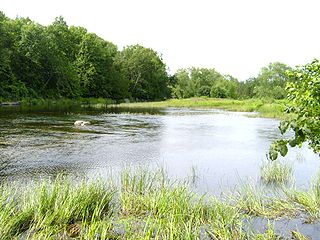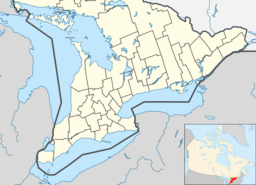| Number Ten Creek | |
| River | |
| Country | Canada |
|---|---|
| Province | Ontario |
| Region | Central Ontario |
| County | Hastings |
| Municipality | Belleville |
| Part of | Great Lakes Basin |
| Source | Unnamed field |
| - elevation | 139 m (456 ft) |
| - coordinates | 44°20′48″N77°22′36″W / 44.34667°N 77.37667°W |
| Mouth | Chrysal Creek |
| - elevation | 104 m (341 ft) |
| - coordinates | 44°16′50″N77°23′55″W / 44.28056°N 77.39861°W Coordinates: 44°16′50″N77°23′55″W / 44.28056°N 77.39861°W |
| Length | 13.1 km (8 mi) |
Number Ten Creek is a creek in the Moira River and Lake Ontario drainage basins in Belleville, Hastings County, Ontario, Canada.

A stream is a body of water with surface water flowing within the bed and banks of a channel. The stream encompasses surface and groundwater fluxes that respond to geological, geomorphological, hydrological and biotic controls.

The Moira River is a river in Hastings County in eastern Ontario, Canada. It travels from its source in the centre of the county to the county seat Belleville to the Bay of Quinte.

Lake Ontario is one of the five Great Lakes of North America. It is surrounded on the north, west, and southwest by the Canadian province of Ontario, and on the south and east by the American state of New York, whose water boundaries meet in the middle of the lake. Ontario, Canada's most populous province, was named for the lake. Many of Ontario's most populous cities, including Toronto, Canada's most populous city, and Hamilton, are on the lake's northern or western shores. In the Huron language, the name Ontarí'io means "Lake of Shining Waters". Its primary inlet is the Niagara River from Lake Erie. The last in the Great Lakes chain, Lake Ontario serves as the outlet to the Atlantic Ocean via the Saint Lawrence River. It is the only Great Lake not to border the state of Michigan.



